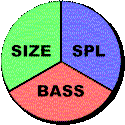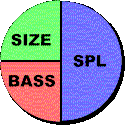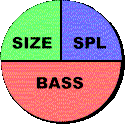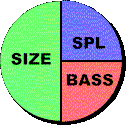|
Loudspeakers have
very definite performance limitations.
If a designer understands those limits he will be in a
better position to "fit" a particular speaker
design to the application at hand. To get some perspective on
the matter, let's start with an exaggerated example of what
we cannot do with a loudspeaker: we can't make a
speaker that goes very low, is highly efficient, and uses a
tiny enclosure.
Imagine a speaker that went to 20 Hz with a sensitivity of
100 dB SPL in a .25 cubic foot enclosure. It is by no means
obvious but such a speaker cannot be made using today's
technology. The loudspeaker analysis developed by Thiele and
Small (so called, "Australian Loudspeaker Theory"
because both of these men were from Australia) shows that
there is a definite relationship between low frequency
bandwidth, efficiency, and box size. I like to compare the
situation to a pie which can be divided into three parts
representing: bandwidth, efficiency, and compactness. The
size of the pie is fixed but you can divide the pie however
you wish. If you want a bigger slice of efficiency then the
bandwidth or compactness slices will have to be smaller
(meaning less bandwidth and/or a larger box). If you want
extended bass response then either the efficiency or the box
will have to give. If you want a tiny enclosure then
bandwidth or efficiency will have to be sacrificed.
Loudspeaker
Tradeoff Factors
|
 |
Traditionally, designs have played out something like
this:
For sound reinforcement applications we
emphasize efficiency at the expense of bandwidth and box
size. That is, sound reinforcement speakers tend to be
efficient but with somewhat limited low end bandwidth and
using large boxes. A typical 3-way box might have the
following characteristics:
Sound
Reinforcement Speaker
Sensitivity: 100 dB SPL
(1W/1m)
Bandwidth: -3 dB at 60 Hz
Enclosure: 3 cubic foot |
 |
For Hi-Fi applications the emphasis is more
on low frequency extension and box size. A typical Hi-Fi
speaker might have the following characteristics:
Hi-Fi
Speaker
Sensitivity: 90 dB SPL (1W/1m)
Bandwidth: -3 dB at 40 Hz
Enclosure: 1 cubic foot |
 |
A Mini Hi-Fi speaker places the emphasis on
size and bandwidth and might have the following
characteristics:
Mini
Hi-Fi Speaker
Sensitivity: 80 dB SPL
(1W/1m)
Bandwidth: -3 dB at 70 Hz
Enclosure: .25 cubic foot |
 |
These are just approximate numbers to give you an idea of how
the tradeoffs go. In any event the following specifications
are NOT physically possible to achieve under
Australian Loudspeaker Theory:
Impossible Speaker!
Sensitivity: 100 dB SPL (1W/1m)
Bandwidth: -3 dB at 20 Hz
Enclosure: .25 cubic foot |
 |
Knowing these
tradeoffs, a speaker designer is more likely to come up with
a good compromise (i.e. pie division) when his customer asks
for a PA speaker that goes to 20Hz, at 110 dB SPL and fits in
his briefcase!
The following mathematical relationship between these
parameters can be found in Small's paper :
Closed-Box Loudspeaker Systems
published in the Journal of the Audio Engineering Society
Vol. 20 No. 10 (DEC 1972)
Efficiency = k * f(3)^3 * V(B)
(where k is the so called "efficiency
constant")
(f(3) is in Hz, and V(B) is in cubic meters)
for closed boxes: k = 2 * 10^-6
for vented boxes: k = 4 * 10^-6
Note that these are maximum
values for the efficiency constants for the two types of
boxes. The actual value depends on the specific alignment of
the system.
Notice the EXTREME sensitivity to f(3) in this
relationship (because it's cubed). A little bit more bass
extension costs you a lot of efficiency or box size. Yet box
volume and efficiency are traded equally. If you want to
reduce the size of the box by half, then efficiency will be
halved also provided the f(3) stays the same.
If we study the efficiency equation we can see that in order
to achieve one octave of bass extension requires a payment of
a factor of 8 in efficiency or box size. For example, say you
have a system that has a F(3) of 80 Hz and you want to
redesign it so that it goes to 40Hz.You could either make the
box 8 times larger or have the system end up 1/8th as
efficient. Or you could make the box twice as large and end
up with 1/4th the efficiency. Either way, you must PAY mother
nature for the extra octave of bass. There can be no
cheating.
It is also important to realize that for typical closed and
vented box systems the efficiency of the system is totally
determined by the choice of driver. Once a driver is selected
you can vary the enclosure to change the bandwidth but the
efficiency will not be affected by the choice of enclosure.
So driver selection is VERY important in the overall design
procedure. In other words, don't expect to get a lot of low
bass from a super efficient pro sound driver. On the other
hand, don't expect to build stage monitors using low
efficiency hi-fi drivers.
Hopefully this shows the role of the speaker designer as one
of compromise. Now, your job is to explain this to your
customer who wants the briefcase speaker for concert sound!
jlm
|